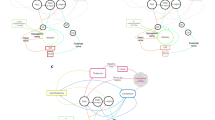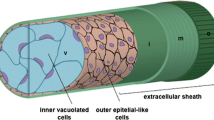Abstract
The relationship between urodele regeneration and the possibility of regeneration in mammals is unclear, but the idea of possible regeneration of neural elements in man is being studied because of its potential clinical importance. One of the great challenges is to gain sufficient knowledge about the basic biology of animal regeneration and to use it for the betterment of the mankind. It is known that the initial stages of urodele limb regeneration depend on the presence of intact nerve fibers connected to their cell bodies. The nerve fibers severed at the level of limb amputation regrow and penetrate the blastema, providing blastema cells with indispensable factors. These factors are produced in the perikarya of neurons and transported via their axons to the blastema. Numerous studies have been performed to elucidate the quantitative relationships between nerve fibers and limb regeneration. However, there are no reports dealing with the individual nerve cells at work. The aim of this investigation was to analyze the quantitative participation and qualitative distinctions of different nerve cells innervating the regenerating parts of the urodele limb and their possible roles in the nerve-dependent and nerve-independent periods of regeneration. The cells under study are housed in the dorsal ganglia (sensory neurons) and in the ventral part of the spinal cord gray matter (motor neurons). The direct involvement of these neurons in different regeneration periods was visualized by means of horseradish peroxidase (HRP) labeling. A total of 34 animals (21 experimental and 13 control) were used to study fluctuations in the numbers of labeled nerve cells. The results are summarized as follows: (a) the first nerve cells incorporating HRP within 5 days after amputation are found in the dorsal ganglia, whereas motor neurons in the gray matter are labeled within 7 days; (b) the number of labeled perikarya increases during the nerve-dependent regeneration period (0–21 days after amputation), with the percentage of implicated sensory neurons exceeding that found in the control series; and (c) during the next, nerve-independent period, the number of participating labeled neurons decreases gradually. Such fluctuations in the number of labeled neurons might represent the metabolic status of these cells in their effort to provide the blastema cells with the factors needed at the appropriate time. The current findings support previous observations that the periods of dependence and independence of urodele limb regeneration on the integrated control of brachial nerves reflect changes in the metabolism of individual sensory and motor neurons.
Similar content being viewed by others
REFERENCES
Anton, H.J., Autoradiographische Untersuchungen über den Eiweisstoffwechsel bei der extremitätenregeneration der Urodelen, Roux's Arch. Entw.-Mech. Org., 1968, vol. 161, pp. 49-88.
Anton, H.J. and Koussoulakos, S., Unilateral Forelimb Amputation Affects Protein Synthesis in Ipsilateral and Contralateral Spinal Cord Ganglia Neurons of the Newt in Vivo, Dev. Neurosci., 1993, vol. 15, pp. 121-127.
Brocke, J.P., Amphibian Limb Regeneration: Rebuilding a Complex Structure, Science, 1997, vol. 276, pp. 81-87.
Brown, A., Slow Axonal Transport: Stop and Go Traffic in the Axon, Nat. Rev. Mol. Cell. Biol., 2000, vol. 1, pp. 153-156.
Chalkley, D.T., A Quantitative Histological Analysis of Forelimb Regeneration in Triturus viridescens, J. Morphol., 1954, vol. 94, pp. 21-70.
Cullen, W., Practice of Physic, Edinburgh: Elliot and Cardell, 1776.
Darwin, C., The Variation of Animals and Plants under Domestication, London: John Murray, 1868.
DiStefano, P.S., Friedman, B., Radziejewski, C., et al., The Neurotrophins BDNF, NT-3, and NGF Display Distinct Patterns of Retrograde Axonal Transport in Peripheral and Central Neurons, Neuron, 1992, vol. 8, pp. 983-993.
Dungan, K.M., Wei, T.Y., Nace, J.D., et al., Expression and Biological Effect of Urodele Fibroblast Growth Factor: 1. Relationship to Limb Regeneration, J. Exp. Zool., 2002, vol. 292, pp. 540-554.
Geraudie, J. and Ferretti, P., Gene Expression during Amphibian Limb Regeneration, Int. Rev. Cytol., 1998, vol. 180, pp. 1-50.
Grimm, M. and Carlson, B.M., The Formation of Muscles in Regenerating Limbs of the Newt after Denervation of the Blastema, J. Embryol. Exp. Morphol., 1979, vol. 54, pp. 99-111.
Haase, P. and Hrycyshyn, A.W., On the Diffusion of Horseradish Peroxidase into Muscles and the Spurious Labeling of Motor Neurons, Exp. Neurol., 1986, vol. 91, pp. 399-403.
Hansson, H.A., Uptake and Intracellular Bidirectional Transport of Horseradish Peroxidase in Retinal Ganglion Cells, Exp. Eye Res., 1973, vol. 16, pp. 377-388.
Holder, N., Clarke, J.D.W., and Tonge, D.W., Pathfinding by Dorsal Column Axons in the Spinal Cord of the Frog Tadpole, Development, 1987, vol. 99, pp. 577-587.
Iten, L.E. and Bryant, S.V., Forelimb Regeneration from Different Levels of Amputation in the Newt Notophthalmus viridescens: Length, Rate, and Stages, Roux's Arch. Entw.-Mech Org., 1973, vol. 173, pp. 263-282.
Kiffmeyer, W.R., Tomusk, E.V., and Mescher, A.L., Axonal Transport and Release of Transferrin in Nerves of Regenerating Amphibian Limbs, Dev. Biol., 1991, vol. 147, pp. 392-402.
Koussoulakos, S., Inherent Cyclic Biological Rhythms Affect Morphogenesis in Regenerating Limbs of Urodele Amphibia, Contr. Zoog. Ecol. East Mediter. Reg., 1999, vol. 1, pp. 211-216.
Koussoulakos, S. and Kiortsis, V., Regeneration: Birth of Experimental Zoology. Physiology. Recent Research Trends, Trends Comp. Biochem. Physiol., 1993, vol. 1, pp. 210-218.
Koussoulakos, S., Margaritis, L.H., and Anton, H.J., Origin of Renewed Spinal Ganglia during Tail Regeneration in Urodeles, Dev. Neurosci., 1999, vol. 21, pp. 134-139.
Kristensson, K. and Olsson, Y., Retrograde Transport of Horseradish Peroxidase in Transected Axons: 3. Entry into Injured Axons and Subsequent Localization in Perikaryon, Brain Res., 1976, vol. 115, pp. 201-213.
LaVail, J. and LaVail, M., The Retrograde Intraaxonal Transport of Horseradish Peroxidase in the Chick Visual System: A Light and Electron Microscopic Study, J. Comp. Neurol., 1974, vol. 157, pp. 303-357.
Lee, J.R., Shin, H., Ko, J., et al., Characterization of the Movement of the Kinesin Motor KIF1A in Living Cultured Neurons, J. Biol. Chem., 2002, vol. 14.
Locatelli, P., Der Einfluss des Nervensystems auf die Regeneration, Wilh. Roux. Arch. Entw.-Mech Org., 1929, vol. 114, pp. 686-770.
Maden, M., The Role of Schwann Cells in Paradoxical Regeneration in the Axolotl, J. Embryol. Exp. Morphol., 1977, vol. 41, pp. 1-13.
Mescher, A.L., Connell, E., Hsu, C., et al., ransferrin Is Necessary and Sufficient for the Neural Effect on Growth in Amphibian Limb Regeneration Blastemas, Dev. Growth Differ., 1997, vol. 39, pp. 677-684.
Mesulam, M.M., Tetramethyl Benzidine for Horseradish Peroxidase Histochemistry: A Noncarcinogenic Blue Reaction Product with Superior Sensitivity for Visualizing Neural Afferents and Efferents, J. Histochem. Cytochem., 1978, vol. 26, pp. 106-117.
Mullen, L.M., Bryant, S.V., Torok, M.A., et al., Nerve Dependency of Regeneration: The Role of Distalless and FGF Signaling in Amphibian Limb Regeneration, Development, 1996, vol. 122, pp. 3487-3497.
Oldfield, B.J. and McLachlan, E., Uptake and Retrograde Transport of HRP by Axons of Intact and Damaged Peripheral Nerve Trunks, Neurosci. Lett., 1977, vol. 6, pp. 135-141.
Peadon, A.M. and Singer, M., A Quantitative Study of Forelimb Innervation in Relation to Regenerative Capacity in the Larval, Land Stage, and Adult Forms of Triturus viridescens, J. Exp. Zool., 1965, vol. 159, pp. 337-345.
Piatt, J., Studies on the Problem of Nerve-Pattern-Innervation of the Regenerated Forelimb in Amblystoma, J. Exp. Zool., 1957, vol. 136, pp. 229-247.
Poulin, M.L., Patrie, K.M., Botelho, M.J., et al., Heterogeneity in the Expression of Fibroblast Growth Factor Receptors during Limb Regeneration in Newts (Notophthalmus viridescens), Development, 1993, vol. 119, pp. 353-361.
Powell, J.A., Analysis of Histogenesis and Regenerative Ability of Denervated Forelimb Regenerates of Triturus viridescens, J. Exp. Zool., 1969, vol. 170, pp. 125-148.
Powell, J.A. and Powers, C., Effect on Lens Regeneration of Implantation of Spinal Ganglia into the Eyes of the Newt, Notophthalmus, J. Exp. Zool., 1973, vol. 183, pp. 95-114.
Ritter, D.A., Bhatt, D.H., and Fetcho, J.R., In vivo Imaging of Zebrafish Reveals Differences in the Spinal Networks for Escape and Swimming Movements, J. Neurosci. 2001, vol. 15, pp. 8956-8965.
Romeis, B., Mikroskopische Technik, München, 1948.
Sandell, L.J. and Adler, P., Developmental Patterns of Cartilage, Front. Biosci., 1999, vol. 4, pp. 731-742.
Schauble, M., Seasonal Variation of Newt Forelimb Regeneration under Controlled Environmental Conditions, J. Exp. Zool. 1972, vol. 181, pp. 281-286.
Schwartz, J.H., Axonal Transport: Components, Mechanisms, and Specificity, Ann. Rev. Neurosci., 1979, vol. 2, pp. 467-504.
Singer, M., The Nervous System and Regeneration of the Forelimb of Adult Triturus: 2. The Role of the Sensory Supply, J. Exp. Zool., 1943, vol. 92, pp. 297-315.
Singer, M., The Nervous System and Regeneration of the Forelimb of Adult Triturus: 5. The Influence of Number of Nerve Fibers, Including a Quantitative Study of Limb Innervation, J. Exp. Zool., 1946, vol. 101, pp. 299-337.
Singer, M., The Invasion of the Epidermis of the Regenerating Forelimb of the Urodele, Triturus, by Nerve Fibers, J. Exp. Zool., 1949, vol. 111, pp. 189-210.
Singer, M., The Influence of the Nerve in the Regeneration of the Amphibian Extremity, Quart. Rev. Biol. 1952, vol. 27, pp. 169-200.
Singer, M., Neurotrophic Control of Limb Regeneration in the Newt, Ann. N.Y. Acad. Sci., 1974, vol. 228, pp. 308-321.
Singer, M. and Salpeter, M., Regeneration in Vertebrates: the Role of the Wound Epithelium, in Growth in Living Systems, Zarrow, M., Ed., New York: Basic Books, 1961, pp. 277-311.
Stephens, N. and Holder, N., The Pattern of Innervation in Serially Duplicated Axolotl Limbs: Further Evidence for Local Pathway Cues , Development, 1987, vol. 100, pp. 479-487.
Stocum, D.L., The Urodele Limb Regeneration Blastema: Determination and Organization of the Morphogenetic Field, Differentiation, 1984, vol. 27, pp. 13-28.
Tassava, R.A. and Mescher, A.L., The Roles of Injury, Nerves, and the Wound Epidermis during the Initiation of Amphibian Limb Regeneration, Differentiation, 1975, vol. 4, pp. 23-24.
Todd, J.T., On the Process of Reproduction of the Members of the Aquatic Salamander, Quart. J. Sci. Lit. Arts 1823, vol. 16, pp. 84-96.
Torok, M.A., Gardiner, D.M., Shubin, N.H., and Bryant, S.V., Expression of Hox D Genes in Developing and Regenerating Axolotl Limbs, Dev. Biol., 1998, vol. 200, pp. 225-233.
Tweedle, C., Transneuronal Effects on Amphibian Limb Regeneration, J. Exp. Zool., 1971, vol. 177, pp. 13-29.
Weiss, P. and Walker, R., Nerve Pattern in Regenerated Urodele Forelimb, Proc. Soc. Exp. Biol. Med., 1934, vol. 31, pp. 810-812.
Wolpert, L., Pattern Formation in Epithelial Development: The Vertebrate Limb and Feather Bud Spacing, Philos. Trans. R. Soc. Lond. B: Biol. Sci., 1998, vol. 29, pp. 871-875.
Yntema, C.L., Regeneration in Sparsely Innervated and Aneurogenic Limbs of Amblystoma Larvae, J. Exp. Zool. 1959, vol. 140, pp. 101-123.
Zenjari, C., Boilly, B., Hondermarck, H., and Boilly-Marey, Y., Nerve-Blastema Interactions Induce Fibroblast Growth Factor-1 Release during Limb Regeneration in Pleurodeles waltli, Dev. Growth Differ., 1997, vol. 39, pp. 15-22.
Author information
Authors and Affiliations
Rights and permissions
About this article
Cite this article
Koussoulakos, S., Margaritis, L.H., Mitashov, V. et al. Quantitative Estimation of HRP-Labeled Sensory and Motor Neurons during Nerve-Dependent and Nerve-Independent Periods of Urodele Limb Regeneration. Biology Bulletin 30, 330–340 (2003). https://doi.org/10.1023/A:1024805721772
Issue Date:
DOI: https://doi.org/10.1023/A:1024805721772




